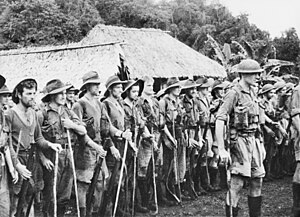Kokoda Track campaign
| Kokoda Track campaign | |||||||
|---|---|---|---|---|---|---|---|
| Part of the Pacific War of World War II | |||||||
 Soldiers of the Australian 39th Battalion in September 1942 |
|||||||
|
|||||||
| Belligerents | |||||||
|
|
|
||||||
| Commanders and leaders | |||||||
|
|
|
||||||
| Strength | |||||||
| 30,000 total | 13,500 total | ||||||
| Casualties and losses | |||||||
| 625 killed 1,055 wounded 4,000+ sick |
6,600 killed | ||||||
The Kokoda Track campaign or Kokoda Trail campaign was part of the Pacific War of World War II. The campaign consisted of a series of battles fought between July and November 1942 between Japanese and Allied—primarily Australian—forces in what was then the Australian territory of Papua. Following a landing near Gona, on the north coast of New Guinea, on the night of 21/22 July, Japanese forces attempted to advance south overland through the mountains of the Owen Stanley Range to seize Port Moresby as part of a strategy of isolating Australia from the United States. Initially only limited Australian forces were available to oppose them; and, after making rapid progress, the Japanese South Seas Detachment under Major General Tomitarō Horii clashed with under-strength Australian forces from the Papuan Infantry Battalion and the Australian 39th Battalion on 23 July at Awala, forcing them back to Kokoda. Following a confused night battle on 28/29 July, the Australians were again forced to withdraw. The Australians attempted to recapture Kokoda on 8 August without success, which resulted in heavy casualties on both sides; and the 39th Battalion was forced back to Deniki. A number of Japanese attacks were fought off by the Australian Militia over the following week; yet, by 14 August, they began to withdraw over the Owen Stanley Range, down the Kokoda Track towards Isurava.
The Japanese failed to press their assault, and the next 10 days proved to be a respite for the Australians. Reinforcements, including the 53rd Battalion and the headquarters of the 30th Brigade under the command of Brigadier Selwyn Porter, arrived to bolster the Australian forces, while the 21st Brigade under Brigadier Arnold Potts also arrived at Isurava by 23 August. The Australians faced significant supply problems despite the modest size of their forces, and the 39th Battalion was withdrawn to ease the logistic burden. The Japanese advance resumed on 26 August, forcing Potts to mount a series of delaying actions as the 21st Brigade successively fell back, first to Eora Creek on 30 August, Templeton's Crossing on 2 September, and next to Efogi three days later, on 5 September. The Japanese were now increasingly hampered by supply problems of their own as they became overextended, while the Australian defence also became better organised. Regardless, the effectiveness of the Australian units was increasingly reduced through exhaustion and sickness from operating in the harsh terrain.
...
Wikipedia
